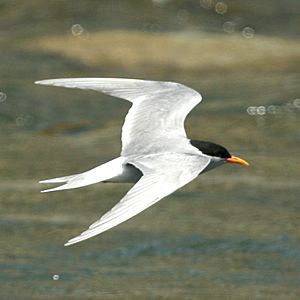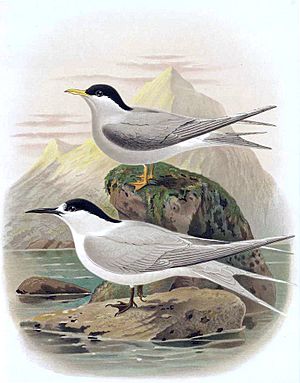Black-fronted tern facts for kids
Quick facts for kids Black-fronted tern |
|
|---|---|
 |
|
| Conservation status | |
| Scientific classification | |
| Genus: |
Chlidonias
|
| Species: |
albostriatus
|
| Synonyms | |
|
Sterna albostriata |
|
The black-fronted tern (Chlidonias albostriatus) is a small bird that lives near fresh water in New Zealand. It's also known by names like sea martin, ploughboy, inland tern, riverbed tern, or tarapiroe. This tern is mostly grey and hunts for small fish, insects, and worms in rivers and lakes.
It only nests in the eastern part of the South Island. Sadly, its numbers are going down. This is because of animals and birds that people brought to New Zealand. The black-fronted tern is now listed as an endangered animal by the International Union for Conservation of Nature (IUCN). This means it's at high risk of disappearing forever.
Contents
Naming the Black-fronted Tern
Scientists give every animal a special name. This helps everyone know exactly which animal they are talking about. The black-fronted tern got its first proper scientific name from George Robert Gray in 1845. He called it Hydrochelidon albostriata.
The name albostriata comes from two Latin words: albus, meaning "white", and striatus, meaning "striped". So, its name means "white-striped". The Māori people of New Zealand call this bird tarapiroe. It's also called "ploughboy" or "ploughman's friend". This is because it often follows farmers' ploughs to find worms and grubs in the freshly turned soil.
What Does It Look Like?
The black-fronted tern is about 29 centimeters (12 inches) long. Adult birds are mostly grey. They have a black cap on their head, which is common for many terns. Their belly and bottom are white. There's also a thin white stripe on their cheeks, just under the black cap.
Its beak is red, and its legs are orange. When it's not breeding season, the black cap on its head becomes less dark and has white spots.
Where It Lives
The black-fronted tern lives in New Zealand. You can find it at the southern tip of the North Island. It also lives along most of the eastern South Island, from Marlborough down to Southland. You might even spot it on Stewart Island. There's also a small group of these birds living near the Buller River and upper Motueka River in southern Nelson.
Nesting and Young Birds
Black-fronted terns only nest in the South Island. They build their nests along riverbanks. When it's not breeding season, they might fly up to 10 kilometers (6 miles) out to sea to find food.
Sadly, many things can harm their nests and eggs. For example, the swamp harrier is a bird that often steals their eggs. Other birds like the kelp gull and South Island oystercatcher also raid their nests.
Helping the Black-fronted Tern
The number of black-fronted terns is going down. This is why they are listed as an endangered species. Many of the threats come from animals that were brought to New Zealand by people.
These include:
- Stoats (a type of weasel)
- Feral cats
- Brown rats
- Hedgehogs
- Dogs
- The common brushtail possum (from Australia)
- The Australian magpie (from Australia)
These animals can eat the terns' eggs or young birds. Protecting these birds means trying to control these introduced animals in the areas where the terns live.
See also
 In Spanish: Charrán fumarel para niños
In Spanish: Charrán fumarel para niños





